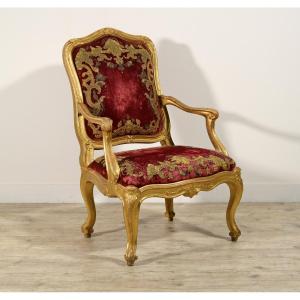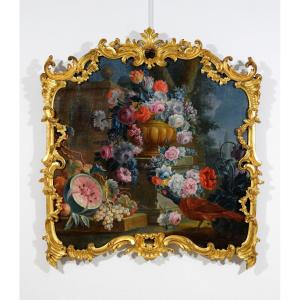Oil on canvas, diameter 71 cm, with frame diameter 80 cm x W 5 cm
The two circular canvases depict two still lifes composed of triumphs of flowers and fruit. The floral arrangements adorn vases with baccellata base, resting on stone bases and are inserted in an outdoor environment, in which lush plants shade the background and the first floor. The paintings are characterized by a bright and lively color palette with which the painter describes the flowers and fruits and in which red, white and white notes of blue prevail. The background in shades of ochre and dark green, serves as a backdrop, highlighting the compositions. The canvas on the left shows, on the right next to some cut flowers on the ground, some peaches and a vine shoot with grapes. In the other canvas, on the right and in the foreground, you can again admire vine leaves and grape bunches. The flowers adorn a vase that culminates with a cantilevered anthropomorphic figure. The elegant compositions, of dramatic impact and great decorative effect, are attributable to the illustrious painter of Piedmontese still lifes Michele Antonio Rapos (or Raposo, not Rapous as many mistakenly write, stunning the name to the French).
Rapos was certainly the best author of still lifes in Piedmont between the second eighteenth and early nineteenth centuries. Much appreciated by the Savoy court and the local nobility, the artist is present in the main court residences and in numerous palaces and private castles throughout Piedmont.
Michele Antonio Rapos was born in Turin in 1733 and died there in 1819. Brother of Vittorio Amedeo, also an important court painter, he specialized in the genre of still lifes and was successful at the Savoy court from which he received commissions for the Royal Palace of Venaria, Stupinigi, for the Royal Palace of Turin. The still lifes of the Rapos have particular characteristics that make them easily identifiable: among the fruits stand out bunches of grapes, peaches, plums, pomegranates, cherries, sometimes melons; among the flowers, often collected in large monumental vases, You can admire delicate roses, soft peonies, carnations and tulips. The architectural and decorative elements, such as the baccellated vases and porcelain, are inspired by the great models of the French tradition, in the taste of the Louis XV style. Rapos interprets the Piedmontese Rococo taste with grace and decorative grace, showing to know the French still life painters of the eighteenth century, such as Jean-Baptiste Blain de Fontenay, François de Cuvilliés and Alexandre-François Desporte. His first still lifes, dating back to around 1755, still have late results, dark backgrounds, lush nature, landscapes surrounded by darkness, from which emerge flowers and fruits, decorative elements. In the canvases presented here, dating from around 1760, the dark background makes the scene more evocative, in which the flowers and fruits stand out with colors, bright and harmonious, tuned mainly in the range of reds, from vermilion to scarlet.
Characteristic of the artist is the use of a delicate brush stroke and the velvety yield of the fruits and petals. In the works you can admire the soft hair that covers the peaches and the patina that distinguishes the freshly picked grapes. The works belong to the most intimate production of the artist, who paints many canvases of similar structure intended for a private collection that loved to adorn the hillside dwellings of Turin, where he spent the summer holidays, with pictures with pleasant and pleasant subjects.
The paintings are presented in gilded wooden frames.
We apologize for any translation errors from Italian. Here to have the expertise in Italian.


















































 Le Magazine de PROANTIC
Le Magazine de PROANTIC TRÉSORS Magazine
TRÉSORS Magazine Rivista Artiquariato
Rivista Artiquariato